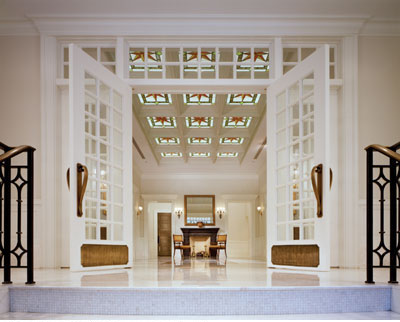Adaptive reuse projects play on premium locations, vintage charm
 While the ultra-luxury market is dominated by new construction, some of Chicago’s top developments fit into the adaptive reuse category, a slot more commonly associated with affordable West Loop lofts than Mag Mile condos.
While the ultra-luxury market is dominated by new construction, some of Chicago’s top developments fit into the adaptive reuse category, a slot more commonly associated with affordable West Loop lofts than Mag Mile condos.
But when it comes to location and charm, older is better in the eyes of some buyers. Of course, in the case of buildings like The Palmolive Building, 159 E. Walton St., and The Ambassador, 1300 N. State Parkway, it’s only the solidly built superstructure that’s old. Buildings like these have been gutted to resurface with all new mechanical systems and the latest technology.
One constant, however, is location. Buildings such as The Palmolive and The Ambassador were constructed on what is now very much prime real estate. The Palmolive commands a front-row seat on the Magnificent Mile and sweeping views of Lake Michigan. At 1300 N. State Parkway, The Ambassador is poised at one of the most desirable Gold Coast addresses, poll position in a built-up area where land seldom becomes available for redevelopment.
The very tangible elements of charm and class that are evident in both developments are also strong points for adaptive reuse projects. In a past life, the art deco The Palmolive Building, built in 1929 by famed architectural firm Holabird and Root, was home to the world-famous Colgate-Palmolive-Peet Co., housed the Lindbergh beacon, a navigational aid to pilots, and even served for a time as the headquarters for Hugh Hefner’s Playboy magazine.
The Ambassador was formerly The Ambassador West Hotel, built in 1924, and a favorite haunt of celebrities like Joan Crawford and Bette Davis.
“I think it’s very charming to be able to live in one of the premier 1920s buildings of the city, [The] Palmolive Building with its beacon, or The Ambassador West Hotel,” says Gail Lissner of housing analyst Appraisal Research Counselors.
Of course, not all adaptive reuse projects are older. Developer JMB Realty is converting floors 21 through 28 of the 66-story Bloomingdale’s Building, at 900 N. Michigan Ave., into The Residences at 900. The building includes Bloomingdale’s and other retail as well as The Four Seasons Hotel. The 48 new condos range from $1.2 million to $4.6 million.
Together, these three ultra-luxury adaptive reuse projects have some of the most sought-after addresses in Chicago.
The downside of buying into a vintage building is that the footprint is already firmly established, and buyers might get units with smaller windows, as opposed to the larger floor-to-ceiling glass windows of many new construction projects.
Tere Proctor of Trump International Hotel and Tower notes that buyers’ tastes cover a broad range. “It’s not [a case of] one versus the other,” Proctor says of the decision to buy new or vintage. “They are two different buyers.”
Landmark status, which both The Palmolive Building and The Ambassador have achieved, also cuts both ways in adaptive reuse projects. While landmark status can often result in substantial tax savings for buyers, it also can limit the scope of renovations. Modern buyers who want balconies added or windows expanded are out of luck at such projects, though presumably, buyers who appreciate a building’s vintage charm would not want to ruin it with such changes.
At The Palmolive Building, the original columns and ornate wall carvings were retained.
At The Ambassador, the developer has also made an effort to restore the building’s original look. “The building is beautiful. It’s back to the way it looked in the 1920s, but with totally new insides,” says Carol Griseto, of L3 Development.
